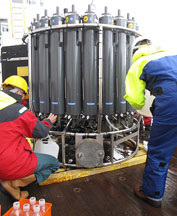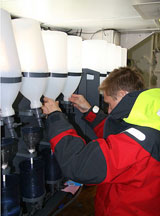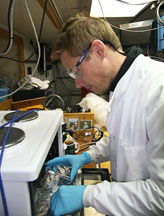Filtering for elemental composition (C:N:P)
After a couple of days steaming northeastwards from the open Atlantic we are now close to UK shores again, just south of Devon in the UK. As I write we are sitting in coccolithophore-rich waters. We are bathed in sunshine, a welcome change! In the next couple of days we will head through the English Channel to the southern North Sea where seawater CO2 is expected to be high and where we will collect water for the fourth bioassay.
The next couple of entries in the blog are written by Dave Suggett of the University of Essex. Today’s blog describes work carried out with Sophie Richier and Mark Moore of the University of Southampton.
One of the great opportunities from this ocean acidification cruise has been to examine how phytoplankton communities vary across a large range of oceanographic conditions, especially between areas of different surface ocean carbon chemistry (and hence pH). Patterns that are generated are key to informing how future changes to ocean chemistry will affect phytoplankton and their role in cycling key elements (including nitrogen, as featured in yesterday’s blog). Sampling across such a wide range of conditions means to some extent that every station tells a different story with a hint of the unknown: what dominant phytoplankton type/species will be present? Do they have all the other macro-nutrients (nitrogen, phosphate and, in some cases, silicate) needed to grow or are they becoming starved? How do these properties affect their role in fuelling the food chain or exporting carbon from the surface waters to deep-ocean?

One of our interests on this cruise is to take water samples from chosen depths, filter it to collect the phytoplankton community and examine a key characteristic - the elemental composition. The elemental composition can be affected by both the phytoplankton group present and their physiological state (as a result of the environmental conditions at any time). How such key properties will be affected by ocean acidification (and the associated implications) remains still almost entirely unknown.
The elemental composition of phytoplankton (its make-up in terms of how much of each chemical element) affects its nutritional quality. Animals that feed on the phytoplankton use it both as a source of energy and a source of nutrients. They tend to struggle to obtain sufficient nitrogen, for instance, and so the amount of nitrogen in each phytoplankton cell is important to them, and also to animals higher up in the food chain. More nitrogen and phosphorus relative to carbon means more ‘quality’, or in other words a better diet for the herbivores and carnivores. Because phytoplankton are at the base of the food chain, their elemental composition has consequences that may be transferred all through the food web, ultimately up to fisheries.
The elemental composition is also important in another way. Previous studies suggest that it affects the amount of carbon absorbed by the ocean from the atmosphere. Models suggest that this could be important as a means of partially offsetting the rise in CO2 from burning fossil fuels. More carbon (C, locked in carbohydrates and organic skeletons) relative to nitrogen and phosphorus (N and P, locked in proteins, amino acids and pigments) means that when some of the particles sink down to the deep ocean under gravity, they will take more carbon down with them. So, if organic particles become more carbon-rich in a high CO2 ocean (we are testing this), then the extra uptake into plankton has to be replaced by an influx of CO2 from the atmosphere. This would ultimately lower the atmospheric CO2 level, or at least diminish its rate of increase.

In order to calculate accurately whether the elemental composition changes with CO2, we have to make sure that the filters are clean before we start filtering. Key here is not to contaminate with any of the elements of interest and so the samples must be collected onto special pre-prepared filters: ‘pre-ashing’ removes any background traces of C or N while soaking in acid (and subsequent flushing with clean water) removes any background P. The samples are subsequently stored for later analysis.

Analysing the samples at a later date comes with the added benefit that the sampling frequency can be substantially increased. Off course the flip side is that the samples then need to be analysed rapidly once returning to lab; also, we are monitoring the filtration rigs almost round the clock to ensure that the samples run smoothly. So far we have collected samples from every CTD cast and bioassay experiment, which together should enable us to look not only for broad-scale biogeographic trends correlated with the seawater carbon chemistry, but also to determine, via the manipulations in the bioassay experiments, the underlying mechanisms driving these trends. Both will be important for making the most accurate longer-term predictions as to how phytoplankton elemental composition will change. On that note, it’s time for another CTD, prepare the filter-rigs and filter yet more seawater (350 litres filtered so far and counting)!

